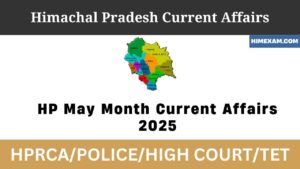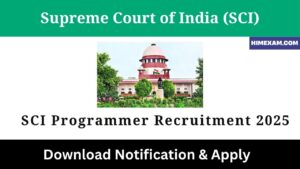Table of Contents
ToggleHistory Of Himachal Pradesh In English
History Of Himachal Pradesh In English :-H.P. Through the study of the history of ancient times, coins, inscriptions, literature, buildings, travelogues and genealogies, we can get information which is available in limited quantity. The details of which are as follows-
Source Of HP History :-
(1) Literature-
- . Puran-Vishnu Purana, Markandeya Purana, Skanda Purana mention the inhabitants of this region.
- . The Ramayana, Mahabharata and Rigveda give details of the tribes inhabiting the Himalayas.
- The regions of Himachal are described in Panini’s Ashtadhyayi, Vrhatsamhita, Kalidasa’s Raghuvansha, Visakhadatta’s Mudrarakshas and Kalhan’s Rajatarangini (which chronicles Kashmir) in 1149–50.
- . There is evidence of Ferozeshah Tughlaq’s attack on the Nagarkot fort at Tarikh-e-Firozshahi and Tithi-e-Farista. Information about the Kangra invasion of Jahangir in Tujuk-e-Jahangiri and the invasion of the Shivalik of Timur Lang from Tujuk-e-Taimuri is obtained.
(ii) coins -hikpr. The work of searching for coins in H.P. After the establishment of the State Museum, momentum began to pick up. The Bhuri Singh Museum and State Museum Shimla have coins of the Trigarta, Oudumbar, Kuluta and Kunind dynasties. 12 coins kept in Shimla State Museum have been received from Arki. 21 coins of Apollodotes have been obtained from village Tappameva in Hamirpur. Some Indo-Greek coins have been obtained from Lachodi and Charol of Chamba. The oldest coinage of Kullu was commissioned in the first century by Raja Virayas.
(iii) Inscription / Tamra Patra – The inscriptions of Pathyar and Kanihara of Kangra, the inscription of the cave of Sunpur at Hatkoti, the inscription of Salunu of Mandi, H.P. You can get information about the socio-economic activities of ancient times. The Bhuri Singh Museum Chamba holds 36 inscriptions received from Chamba which are written in the Sharda and Tankari scripts. The information about the Gupta period is obtained from the Shalaru records of Kullu. There is an inscription of Ashoka in the Jaunsar-Bawar region located at the confluence of the Tons and the Yamuna River. The seventh-century Mahasamanta in Nirmand is the copper sheet of Samudrasena.
(iv) Building –The Kangra Fort, the temples of Bharmour, the ruins of Sirmauri Tal, the temples of Kamru, Naggar, Tabo and Ki Buddhist Vihara also provide information about the history of ancient Himachal.
(v) Genealogies – Moorcraft first worked towards the genealogies and helped in finding the genealogies of the kings of Kangra. Captain Harcourt received the lineage of Kullu. Later Cunningham discovered the genealogies of the kings of Kangra, Chamba, Mandi, Suket and Nurpur.
( vi) Travelogue – H.P. The most archaic description of Ptolemy is given in which the description of Kulindas is given. The Chinese traveler Hiuen Tsang stayed in India until 630–644 AD. During this time he also came to Kullu and Trigarta. Thomas Koryat and William Finch, during the time of Jahangir. Traveled to Forster 1783, William Moorecraft 1820-1822, Major Archer wrote about Himachal in the 1829 travelogue. Also Alberuni (1030) (with Mahmud Ghaznavi) has described this region.
👉 Prehistoric and Vedic Period
(a) Pre-historic Himachal – The script was not developed in pre-historic times. We do not find any written source of human beings of this time. We depended only on archaeological sources for this period. This period is divided into Palaeolithic period (30 lakh to 10 thousand BC), Midolithic period (1000BC-4000BC) and Neolithic period (7000BC-1000BC) –
The Proto-historic period is called the period in which the script was there, but it has not been read yet, like Harappa
(1) Palaeolithic sources – Olaf Prufer in Nalagarh on the right of Sirsa, a tributary of Sutlej, in 1951, has received stone tools such as hooves etc. In 1955, B.B. Lal has obtained samples of equipment of 72 types of Adisohan type from Guler, Dehra, Dhaliara and Kangra. Among them are chapras, hand axes and Vedani. Dr. GC Mahapatra has also found the remains of stone tools of the post-Stone Age (30 lakh-4 lakh years ago) in the Sirsa river valley and Kangra. Remnants of this period have been found in 1974 in the Suketi area of Markanda River at Sirmour.
(2) Medieval and Neolithic sources – In India, this period (10000BC-1000BC) is considered one, while it is divided into Europe. Permanent agriculture and civilizations originated during this period. Evidence of Neolithic age has been found at Kotla-Nihang in Ropar.
In the foothills of the Saraswati-Yamuna rivers, brown images have been found made in pottery.
(3) Ancient (at the time of Indus Civilization) residents of Himachal –
- Cole – Cole H.P. Are natives of who laid the foundation of Neolithic culture. In the Western Himalayas, the present-day Koli, Hali, Doom, Chanal, Badhi etc. are from the Kol caste. H.P. of Cole caste Settling in is found from the rocks of the Chandeshwar valley of Kumaon.
- Kirat- Kirat (Mongol) was the second caste to come here after the Kol caste. The sage Vashistha calls him Shishnadeva (the worshiper of the linga deity). In the Mahabharata, rents are said to be residents of the Himalayas. Chapter 140 of Vanaparva (Mahabharata) describes his residence. The kirats were happy to drive them from the mountainous foothills to the high mountains. Manu has also described the rents. Kinnars are mentioned in Kalidasa’s Raghuvansh.
- Nagas – People of this caste used to live everywhere in the hills of Himachal. The Panchavakatra Shiva temple in Mandi has 10 feet high idols of serpents. The snake deity is depicted in the seals of the Harappan civilization. In the Mahabharata, Arjuna married Gandharva to Naga king Vasuki’s Naga girl named Ullopi. Vasuki Nag is worshiped in Chamba, Kullu etc. Takshak Nag established the Nag state in the Himalayas.
- Khas- The third branch of Aryans which spread across the Himalayas from Central Asia through Kashmir, is called Khash caste. His residence is found in a village named Khashkandi, Khashdhar in Rohnu region.
(4) Ancient deity-
- Shiva – The evidence of worship of such a god is found by the initial residents of Himachal, who are similar to Shiva. An example of this is the temple of Manimahesh, Kinnar Kailash, Mahasu Devta. The oldest religion of Himachal is Shaivism. Evidence of the worship of Pashupati Devta is found in the Indus Valley Civilization.
- Shakti-HP In addition to Shiva worship, Shakti Puja was also done. It became famous in the mythological period by the names Durga, Kali, Amba and Parvati. Shakti Devi in Chhatrani, Lakshana Devi in Bharmour, Brajeshwari Devi Temple, Jwalamukhi, Hidimba Devi Kullu, Nainadevi Bilaspur, Hateshwari Devi Hatkoti and Bhimakali Sarahan H.P. There is ancient evidence of worshiping Shakti.
- Nag Devta – Ancient evidence of many temples and places of worship of Nag Devta. Received in
(5) Arya and Himachal – A branch of Aryans entered India via Central Asia. These were called Vedic Aryans. These people brought their livestock, deities and household items and proceeded towards Sapta Sidhu region. It took them 400 years to settle down completely. While moving from Sapta Sindhu (Punjab) to Shivalik, the Vedic Aryans encountered the ancient inhabitants of Kol, Kirat and Naga caste here. There were forts. According to the Rigveda, there was a 40-year war between the Dasyu king Shambar and the Arya king Divodas. In the end, Divodas killed Shambar at a place called Udbraj. The Aryans forced Kol, Kiratas and Nagas to move from the lower valleys to the inaccessible hills. Rishi Bharadwaj was the chief advisor to the Arya king Divodas.
II. Vedic Period-
(1) Vedic Aryans – Yayati, the powerful king of Vedic Aryans, laid the foundation of his kingdom on the banks of river Saraswati. After that his son Puru became the ruler of this state.
- Dusharag War – According to Rigveda, the war of Sudas, son of Divodas, took place between ten Arya and non-Aryan kings, which is called Dusharag war. Sudas’s army was led by his mentor and minister Vasishtha, while the other ten kings’ armies were led by Vishwamitra. Sudas’s army defeated the army of ten kings (Puru kingdom). After this Sudas became the most powerful king of the Rigvedic period. This war took place on the banks of river Ravi.
(2) Vedic sage – Mandi is associated with Mandavya sage, Bilaspur with Vyasa sage, Nirmand with Parashurama, Manali with Manu sage and Vashishta Kund hot water glasses located near Manikaran in Kullu valley are associated with Vedic sage Vashistha. .
- Jamadagni Rishi – Jamadagni Rishi is worshiped in the village of Malana as the deity of Jamlu. The place where the sage Jamdagni resided was called Jamu ka dune. It is located near Renuka in Sirmaur district. Jamadagni was the wife of the sage Renuka. The temple of Parasurama of Jamadagni Maharishi is located near Renuka Lake. Agastya and Gautam Rishis also built their ashrams around Renuka and went to reside at other places in the latter.
- Sage Parasurama – When the Vedic Arya king Sahasrarajun (Kirtavirya) reached Renuka, he was welcomed by the sage Jamadagni there. Sahastrajarjuna demanded the Kamadhenu cow from the sage Jamadagni, which the sage refused to give. Enraged at this, he destroyed the ashram of the sage Jamadagni and looted his cows. Parashurama formed a union of local kings and castes and attacked and killed them. The sons of Sahasrarajun killed the sage Jamadagni. This provoked Parashurama and started attacking all the Kshatriyas.
(3) Mahabharata period and H.P. Himachal has been called Himavant in the four ancient districts of the Rigveda. In the Mahabharata, the Pandavas spent an unknown period of time in the upper hills of Himachal. Bhimsen married the total goddess Hidimba of Kullu during the exile period. Trigarta king Susharma fought on behalf of the Kauravas in the Mahabharata war. The rulers of Kashmir, Oudumbar and Trigarta taxed Yudhishthira. The Kulind princely state had accepted the subjection of the Pandavas. In the Mahabharata, the description of 4 districts, Trigat, Oudumbar, Kulind and Kulut is found.
- Oudumbar- According to Mahabharata, Oudumbar was a descendant of Vishwamitra who is related to Kaushik Gautra. Oudumbar state coins have been found in the areas of Kangra, Pathankot, Jwalamukhi, Gurdaspur and Hoshiarpur confirming their habitat. These people used to worship Shiva. A description of the Oudumbar caste is also found in the Ganpath of Panini. Due to the multiplicity of the Adumbar tree, this district is called Oudumbar. In the Brahmi and Kharoshthi script the word Mahadevasa is found on the coins of Oudumbars which symbolize ‘Mahadev’. The trident is also inscribed on the coins. Oudumbars carried copper and silver coins. Oudumbar was a devotee of Shiva and a sheepman who may have had a connection with the Gaddi tribe of Chamba.
- Trigart – The district of Trigart was founded by Bhumichand. Susarma was the 231st king of his generation. Susharma Chandra assisted the Kauravas in the Mahabharata war. Susharma Chandra attacked the Matsya king Virat, who was his neighboring kingdom, giving shelter to the Pandavas in the unknown. Trigarte was a stretch between the rivers Ravi, Vyas and Sutlej. Susharma Chandra built the Kangra Fort and made Nagarkot its capital. Kanishka described the 6 state groups as part of the Trigarta. Kaurava Shakti, Jalmani, Janaki, Brahmagupta, Dandki and Kondopratha were parts of Trigarta. Panini has called Trigarta an Ordnance Association which means – the people living on the war. Trigarta is also mentioned in the Ashtadhyayi of Panini, Rajatarangini of Kalhana, Vishnu Purana, Brihatsamhita and Dronaparva of Mahabharata.
- Kullut – The Kullut kingdom was the area above the Beas river, which is found in the Ramayana, Mahabharata, Vrhatasamhita, Markandeya Purana, Mudrarakshas and Matsya Purana. Its ancient capital was Naggar, which is found in Panini’s Katreyadi Ganga. The oldest coinage in the Kullu Valley is known as Raja Viryas in 100 AD. It is written in Prakrit and Kharoshthi language. The princely state of Kullut was founded by Vihangamani Pal, who came from Prayag (Allahabad).
- Kulind-According to Mahabharata, Kulind was conquered by Arjuna. The Kulind princely state was the land between Vyas, Sutlej and Yamuna which included the areas of Sirmaur, Shimla, Ambala and Saharanpur. The kunait or kainait of the present day is believed to be related to Kulind. The name of King Amoghbhuti is inscribed on the silver coin of Kulind. The mythical name of river Yamuna is Kalindi and the area along with it is called Kulind. Due to the abundance of Kulind (Behera) trees in this region, this district must have also got its name Kulind. In the Mahabharata, Arjuna conquered the Kulindas. Kulind Raja Subahu presented gifts to Yudhishthira in the Rajasuya Yajna. Kulindas have also received the Bhagavata Chatreshwar Mahatmaan posture of the second century. The Kulindas had a republican system of governance. The Kulindas, along with the Punjab warriors and Arjunayan, had succeeded in driving away the Kushanas.
👉 Mauryan and post-Mauryan period
(1) Mauryakala
- . Alexander’s invasion – Alexander invaded India in 326 BC and reached the Vyas river. Alexander’s troops refused to go beyond the Vyas river. The chief of this was his commander Koinos. Alexander built twelve stupas on the banks of the Vyas river as a sign of his India expedition, which have now been destroyed.
- Chandragupta Maurya – Chandragupta Maurya, along with the hill king Parvatak and his Prime Minister Chanakya, took steps towards the establishment of the Maurya Empire. The treaty between Parvatak and Chanakya is found in Visakhadatta’s Mudrarakshas and the Jain texts Appendix. According to Mudrarakshas Chandragupta recruited Kirat and Khashs in his army. The mountain must have been a three-way king. Among the hill kings, only King Chitravarma of Kulut and Raja Pushkaraksha of Kashmir opposed Chandragupta. 323 BC with the help of Chanakya. In Chandragupta destroyed the Nand Dynasty and sat on the throne and established the Maurya Empire. The kingdom of Kulind was called Shirmourya in the Mauryan period because the Kulind state was situated at the apex of the Maurya Empire. Later, it became the Sirmour Sirmour.
- Ashoka- The grandson of Chandragupta Maurya, Ashoka, sent Majhim and 4 Buddhist monks to propagate Buddhism in the Himalayas. According to Hensong, Ashoka had built Buddhist stupas at Kullu and Kangra. Ashoka-built inscriptions have been found at Kalath in Kullu and Chaitadu in Kangra. The Ashoka-era inscriptions have been found in Kalsi (Uttarakhand). In the promotion of Buddhism in the Himalayan region, Buddhism was supported by 4 Buddhist monks Kassapgota, Dhundhobhisara, Sahadeva and Mulakdev. H.P. In 242 BC, Buddhism was entered. The Mauryan kingdom of Kapatan started around 210 BC, which was completed by the establishment of the Shug Dynasty in 185 BC.
(i i) Mauryatara period (Shug, Kushan dynasty) – After the fall of the deaths the Sunga dynasty could not keep the hill republics under them and they became independent. The Shakas invasion began around the first century BCE. In the reign of Kanishka, the most prominent king of the Kushanas after the Shakas, the hill states surrendered and accepted Kanishka’s subjugation. 40 Kushan coins have been found on the Kalka-Kasauli road. A coin of Kanishka has been found at Kanihara in Kangra. The hill kings were free to run their coins with the Kushanas. In the late second and early third centuries, the Yudhudayas, Arjunayan (Punjab) and Kulindas, together with the Kushans’ weakening power, pushed the Kushanas across the Sutlej and carried coins as a token of their independence.
👉 Gupta period
Srigupta’s grandson Chandragupta I laid the foundation of the Gupta Empire in 319 AD. Napoleon ‘Samudragupta of India conquered the mountainous districts in 340 AD and acquired the suzerainty over him. From the Allahabad (Prayag) commendation of Harishan, Bhadra, Trigarta, Oudumbar, Samudragupta’s victory over the Kullut and Kartikpur districts finds mention. All the kings accepted his subjugation and made him like a vassal. Kulind district is not mentioned in it. Shadad He must have come under the Gupta Empire at the time of Chandragupta I. Samudragupta conferred his sovereignty over the hill districts and gave him the freedom to maintain inner freedom, strength and security. Skandagupta, the son of Kumar Gupta, defeated the Huns and maintained the prestige of the Gupta empire. After Skandagupta, the influence of the Gupta Empire began to decline and was disbanded. The invasion of the Huns was the main reason for the decline of the Gupta Empire. Kalidas composed Kumarasambhava and Meghdoot in this period, in which the description of the Himalayas is found. During the Gupta period, the influence of Hinduism increased in the mountainous regions and many temples were built. Get a description of. During the Gupta period, the influence of Hinduism increased in the mountainous regions and many temples were built. Get a description of. During the Gupta period, the influence of Hinduism increased in the mountainous regions and many temples were built.
👉 Gupta period (Hoon, Harshavardhana)
(i) Hunas Invasion- In 521 AD, Hunas invaded the western Himalayas under the leadership of Toraman. Even before this, between 480-90, the Toramas invaded the Gupta Empire. After the Toraman, his son Mihirkul, who was called Attila of India, took over the region from Punjab to Central India in 525 AD. Magadha emperors Narasimha Baladitya and Yashovarman defeated Mihirkul and forced him to flee to Kashmir. The Gujjars consider themselves descendants of the Hunas.
(ii) Harsh Vardhan and Hiuensong-Harshavardhana ascended the throne of India in 606 AD. Pataliputra, Thaneshwar and Kannauj were the main centers of governance during his reign. During his reign, Hiuen Tsang traveled to India from 629-644 AD. Hieun Tsang came to Jalandhar (the capital of Jalandhar-Trigarta) in 635 AD and was the guest of King Uitas (Udima) for 4 months. He stayed in Jalandhar in 643 AD at the time of China’s return to India. Hiuen Tsang had traveled to Kullu, Lahaul and Sirmaur after Jalandhar. Harshavardhana died in 647 AD. Kalhan’s book Rajatarangini gives details of the war between King Lalitaditya of Kashmir and Yashovarman. Details of Yashovarman’s influence on Trigarta, Brahmapura (Chamba) and other mountainous regions are found. In the ninth century, the state of Kashmir became the authority of the Trigarta and Upper Sutlej regions. Hiuen Tsang had the capital of Jalandhar (She lan-Talo), Kulut, Sirmaur (Shatrughan), Sirmauri Tal, Has given a detailed description of the journey to Lahaul (Lo-Oo-Lo). The state of Chamba may have been under Trigarta at that time. He has mentioned the prevalence of Mahayana religion in his book Si-u Ki. The description of Samudrasena, the king of Spiti, is found in the copperplate of Nirmand. H.P. In addition to Trigarta and Kullut, small groups of chieftains emerged who were called Thakurs and Rana. In the post-Gupta period the Thakurs’ reign was called Apathakurai and the jurisdiction was Ukkurai. The jurisdiction of the Ranaas was called Rahun. Rajputs who came from the plains between the seventh and tenth centuries established their dynasties in Himachal. They brought the Rana and Thakurs to the status of their feudal lords. In addition to Trigarta and Kullut, small groups of chieftains emerged who were called Thakurs and Rana. In the post-Gupta period the Thakurs’ reign was called Apathakurai and the jurisdiction was Ukukurai. The jurisdiction of the Ranaas was called Rahun. Rajputs who came from the plains between the seventh and tenth centuries established their dynasties in Himachal. They brought the Rana and the Thakurs to the status of their feudal lords.
Medieval history :-
|| medieval history of hp || medieval history of himachal pradesh in ||
|| Modern History of hp || Modern History of Himachal Pradesh || Modern History of hp in Hindi ||
|| Modern History of hp || Modern History of Himachal Pradesh || Modern History of hp in Hindi ||
More Pages:-
हेलो दोस्तों ,आपका हमारी वेबसाइट Himexam.com पर स्वागत है। जैसा की आपको पता है हमारी वेबसाइट Himexam.com आपको समय-समय पर सभी HP Govt Jobs & All India Govt Jobs की Notifications प्रदान करवाती है। साथ ही साथ Himachal Pradesh Exam Previous Paper और Himachal Pradesh GK ,Himachal Pradesh & National +International Current Affairs के सभी नोट्स मुफ्त उपलब्ध करवाते है। हमारी वेबसाइट के अलग अलग प्लेटफार्म पर pages & Group बने है जैसे की facebook ,Telegram और Instagram .. अगर आप हिमाचल के किसी भी पेपर की तैयारी कर रहे हो तो जल्दी से इन groups के साथ जुड़ जाएं इनके लिंक नीचे table में दिए गए है।
Join Us:-
| Like Our Facebook Page | Click here |
| Join Us oN Telegram | Click here |
| Join Us On Instagram | Click Here |








